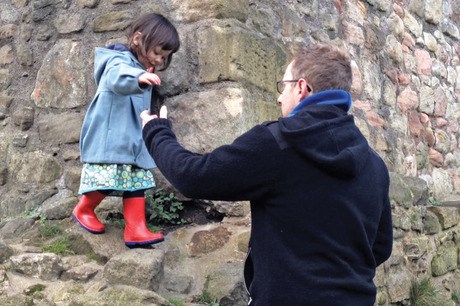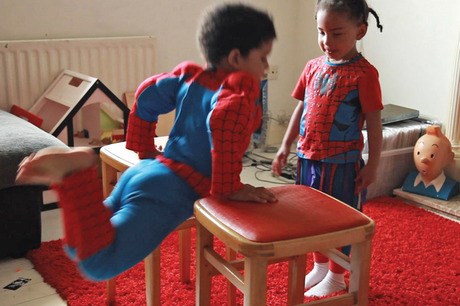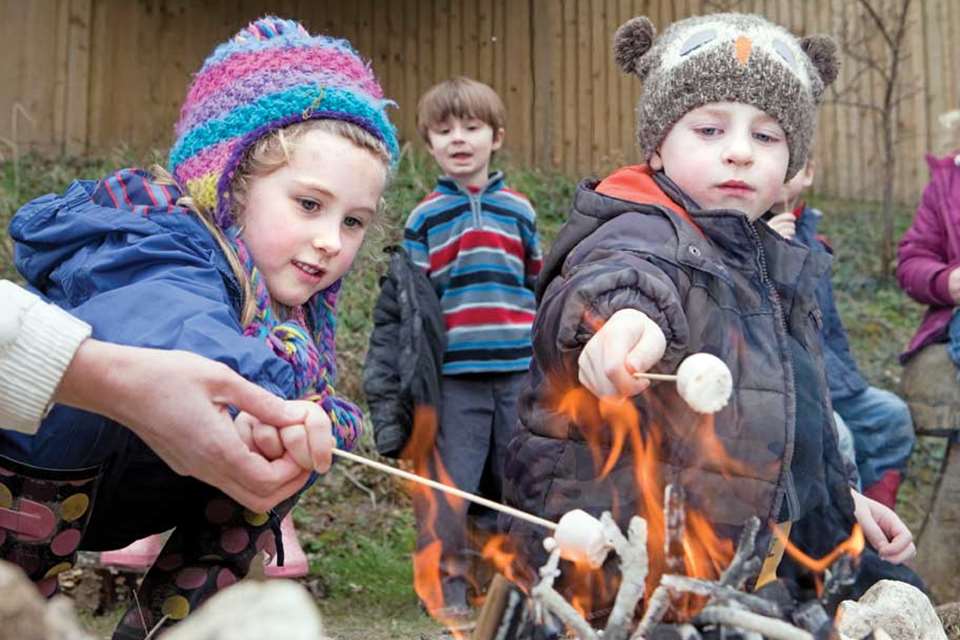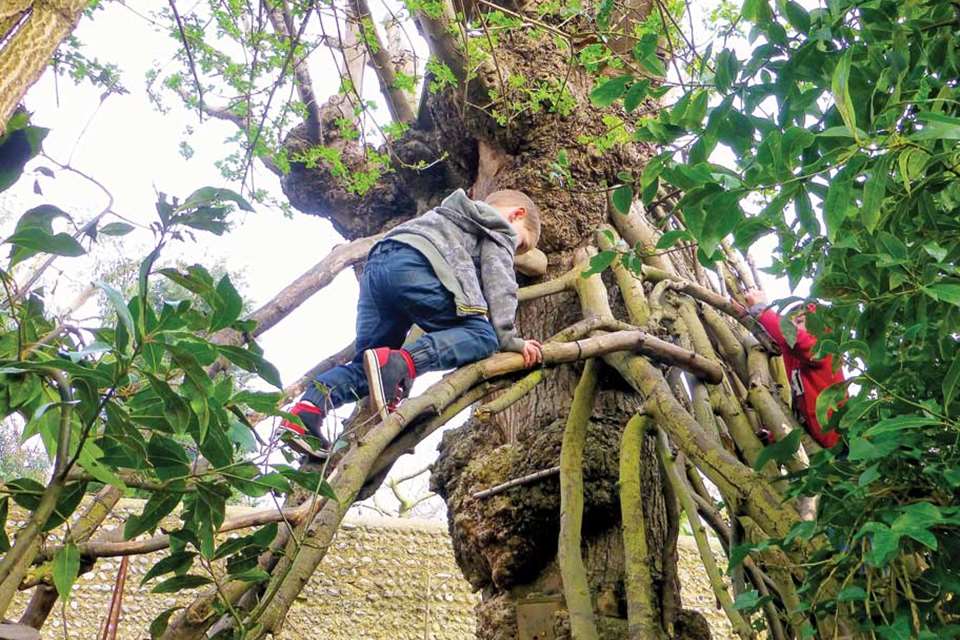Enabling Environments: Risk - Under the surface
Kathryn Solly
Monday, January 26, 2015
Risk-taking is a key ingredient of healthy development, but its place in practice can still be limited by how it is perceived, says Kathryn Solly.

Every young child needs the best possible start in life and parents must feel confident that their children are safe and well looked after. Equally, they should expect their child to be appropriately challenged by their learning being extended according to their individual interests and needs.
The opportunities for young children to play freely indoors and out have changed dramatically in recent years. This has well-documented impacts on their health, understanding of the natural world, independence, well-being and liberty.
It is well recognised that young children benefit from the genuine experience of self-initiated play. However, since the time of Froebel, Montessori, Dewey and Rousseau, such 'free play' has been, and remains, a political and philosophical concern, as it is often misunderstood and used to control and sometimes restrict play in relation to its perceived benefits for learning, education and life.
Giving children real choices of a variety of natural and man-made play materials within both indoor and outdoor environments provides for the natural and varied development of their curiosity, imagination and creativity. These environments allow children to spontaneously co-create dramas, stories and active games in a rich, hands-on interactive fashion. This, in turn, can develop their environmental literacy, self-expression and leadership skills.
From birth onwards, children use interactions, movement and manipulation to discover a variety of concepts such as 'light/dark', 'heavy/light', 'over/under' and 'near/far', as well as gaining and practising an expanding range of skills, understanding and knowledge. Over time their territorial range in terms of time and space also expands within their environments.
Elements such as water, fire, earth, and experience of changing seasons, plants and animals provide rich opportunities for exploration, discovery and social interaction. However, some practitioners may consider such experiences as hazardous and avoid them for fear of injury, harm or potential litigation.
DESIRE TO LEARN
There is no guaranteed means to ensure complete safety for children in their play while satisfying their powerful desire to discover for themselves. If you do not understand the possibilities of these elements and natural occurrences, how can you effectively manage and deal with them?
Young children will seek out challenges because they are innately curious. These challenges engage their interests, and extend their curiosity and desire to learn, while motivating further risk-taking suited to their unique developmental level.
Children are not foolish and they are quite able to recognise risks and potential hazards even at a young age if such things are discussed and demonstrated to them.
Consider such fascinating activities as woodwork, using the hosepipe or cooking on a fire bowl. These represent large areas of cross-curricular learning and establish real reasons for children to make wise judgements and take action to ensure their ongoing safety within the limits of their own experience.
Terms such as 'dangerous' and 'safe' are unclear, loaded and imprecise - and therefore not useful. Hazard can be defined as 'any potential source of harm, or danger, which is unacceptable.' Even the safest materials and environments can create hazards under certain circumstances and thus it is impossible to eliminate everything that is potentially harmful.
However, risk is also often defined negatively and often closely associated with hazard. It is often seen as 'a situation involving exposure to danger', whereas the term 'challenge' is defined as 'a task or situation that tests someone's abilities'. This then seems to fit closely with that of adventure - 'an unusual and exciting or daring experience'.

SATISFACTION OF ACHIEVEMENT
Risk is present in everyday life situations and without it life would be very boring. A reasonable level of risk is necessary, if not essential, in play to give it the thrill or 'flow' of satisfaction of achievement.
The research of Czech psychologist Mihaly Csikszentmihalyi explains clearly how flow usually results when skills are concentrated on overcoming a challenge that is just manageable. It demands full attention and concentration and acts as a 'magnet for learning - that is developing new levels of challenges and skills' (1997:33). Therefore, children must have opportunities to challenge themselves and extend their horizons through risk-taking.
The work of David Ball, Tim Gill and Bernard Spiegel for the Play Safety Forum (2014) on risk benefit assessment highlights the crucial importance of a degree of risk being beneficial in play situations. They define risk-benefit assessment as 'a tool to aid risk management that explicitly brings together considerations of risks and benefits in a single judgement'. This is because it gives a real chance for children to encounter hazards and through this learn to assess and manage them.
The report stresses the difficulty of making judgements due to the uniqueness of children and the variety of circumstances. It emphasises the need for practitioners to reconsider their principles and practice through training and careful consideration of the possibilities to be gained from this approach.
By starting to use the terms 'challenge' and 'adventure', we can reduce the negative aspects of risk and hazard while maintaining or expanding the future opportunities of risk-taking through risk-benefit assessment. This can provide chances for children to experience new opportunities, do things a little differently or undertake a new experience to expand their horizons and potential achievements. Practitioners will also have taken 'all reasonable precautions' to eliminate hazards while providing for the essential experiences of risk-taking through physically and intellectually challenging play.
PERCEPTIONS AND POSSIBILITIES
Any good and caring parent would desire hazards such as hidden sharp objects, protrusions and poorly designed or faulty equipment with finger or head traps to be avoided. The potential for falls is probably the greatest concern in terms of height, stability and surfacing, so trees, rocks, climbing features, walls, gates, doors and fences will need careful consideration.
Children can get into spaces too small for adults and their fingers provide useful tools to investigate crevices an adult may not even see. So children must have the opportunity to work out what is hazardous when faced with a risk-taking situation by being involved in risk-benefit assessment.
We need to think carefully about changing perceptions and possibilities. We need to use our principles, and accept that risk-taking is non-negotiable and is a valuable starting point for life-long learning and survival. Practitioners should make continuous judgements about young children's interactions with their environments both indoors and out so that a mutually acceptable balance of risk-taking is possible.
Real opportunities for risk-taking for young children can seem threatening and dangerous to practitioners, but if considered as appropriate developmental challenges then many more learning possibilities arise. We all need to accept that bumps, bruises, grazes and cuts are a natural part of play through which we learn.
Environments that are designed to be 'safe' are usually sterile and offer little or no benefit for play and limited extension for children. In fact, the real danger is that children may search out unsuitable or inappropriate challenges that are really hazardous due to the circumstances that confine them.

RISK, CHALLENGE AND ADVENTURE
Risk, Challenge and Adventure in the Early Years: a practical guide to exploring and extending learning outdoors by Kathryn Solly (David Fulton, £18.99 on Kindle or £19.99 in paperback) gives early years practitioners the confidence and knowledge to reflect on and enhance their outdoor learning for young children.
It combines definitions of 'risk', 'challenge' and 'adventure', well-presented arguments on the benefits of 'adventurous' play to young children, and guidance on how to support 'challenging' play outdoors.
Best of all, it is heartening, encouraging practitioners to adopt the positive language of 'challenge' and 'adventure' and so reduce the negative aspects of 'risk' and 'hazard'.
- the pedagogical history of adventure, risk and challenge- environments that enable challenging and adventurous play
- adventurous activities throughout the year
- health, well-being and keeping safe
- the adult role
- risk assessment
- supporting individual children with different needs
- working with parents and addressing concerns
- observation, planning and assessment.
]]








